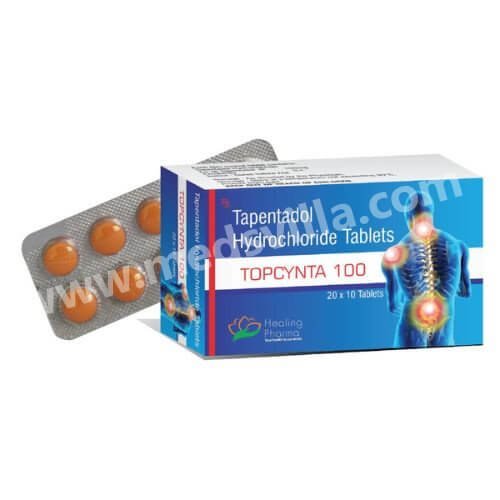Topcynta 100mg is a medication that has garnered attention for its effectiveness in treating various conditions. It contains Tapentadol, a unique analgesic that functions as both a mu-opioid receptor agonist and a norepinephrine reuptake inhibitor (NRI).
This dual mechanism of action makes Topcynta an important option for managing pain, particularly for patients who may not respond well to traditional opioids or those seeking alternative therapies. In this blog post, we will explore the benefits of Topcynta 100mg, its uses, mechanism of action, side effects, and important considerations for patients.
Understanding Tapentadol and Topcynta
What is Tapentadol?
Tapentadol is an analgesic that combines opioid and non-opioid properties, making it effective for various types of pain. It is classified as a Schedule II controlled substance due to its potential for abuse, similar to other opioids. However, it is distinct in its pharmacological profile, allowing for effective pain relief with potentially fewer side effects compared to traditional opioids.
What is Topcynta 100mg Used For?
Topcynta 100 mg is primarily prescribed for the management of moderate to severe pain. Common conditions that may warrant the use of Topcynta include:
- Chronic Pain: Conditions such as arthritis, fibromyalgia, and back pain that require ongoing pain management.
- Postoperative Pain: Pain following surgical procedures, where effective analgesia is essential for recovery.
- Neuropathic Pain: Pain resulting from nerve damage or dysfunction, which may not respond well to standard pain medications.
Benefits of Topcynta 100mg
1. Dual Mechanism of Action
One of the standout features of Asmanol 100mg is its dual mechanism of action. By acting as a mu-opioid receptor agonist and norepinephrine reuptake inhibitor, Tapentadol provides effective pain relief while also addressing the underlying mechanisms of pain perception. This combination can be particularly beneficial for patients who experience pain that is both nociceptive (due to injury or inflammation) and neuropathic.
2. Reduced Risk of Side Effects
Compared to traditional opioids, Topcynta may have a more favorable side effect profile. While it can still cause common opioid-related side effects such as nausea, dizziness, and constipation, some studies suggest that Tapentadol may result in fewer gastrointestinal issues and a lower incidence of sedation. This can improve patient compliance and overall satisfaction with pain management.
3. Lower Abuse Potential
Due to its unique properties, Tapentadol may have a lower potential for abuse compared to other opioids. While it is still classified as a controlled substance, some studies indicate that patients using Topcynta report lower cravings and misuse compared to traditional opioid medications. This aspect is particularly important in the context of the opioid epidemic, where safer alternatives are needed.
4. Versatile Pain Management
Topcynta is effective for various types of pain, making it a versatile option for patients. Whether the pain is acute or chronic, nociceptive or neuropathic, Topcynta can provide relief. This versatility allows healthcare providers to use Topcynta in different clinical scenarios, tailoring treatment plans to individual patient needs.
5. Improved Quality of Life
By effectively managing pain, Topcynta can significantly improve a patient’s quality of life. When pain is well-controlled, patients can engage in daily activities, participate in social interactions, and maintain their mental and emotional well-being. The reduction of pain can lead to enhanced productivity and an overall sense of normalcy in life.
6. Patient-Centric Approach
Topcynta is often prescribed with a patient-centric approach, considering individual pain management needs and potential side effects. This personalized treatment philosophy enables healthcare providers to monitor patients closely and adjust dosages or treatment plans as necessary, ensuring optimal pain relief with minimal adverse effects.
Important Considerations
While Topcynta 100mg offers numerous benefits, it is essential for patients to be aware of certain considerations before starting treatment.
1. Potential Side Effects
As with any medication, Topcynta can cause side effects. Common side effects may include:
- Nausea
- Dizziness
- Drowsiness
- Constipation
- Fatigue
Patients should discuss any concerns about side effects with their healthcare provider, who can provide guidance on managing them.
2. Interactions with Other Medications
Topcynta may interact with other medications, including certain antidepressants, sedatives, and other opioids. Patients should provide their healthcare provider with a complete list of all medications they are taking to avoid potential interactions.
3. Dependency and Withdrawal
While Tapentadol has a lower abuse potential compared to traditional opioids, there is still a risk of dependency, especially with prolonged use. Patients should use Topcynta only as prescribed and should not abruptly stop taking the medication without consulting their healthcare provider, as withdrawal symptoms may occur.
4. Contraindications
Topcynta may not be suitable for individuals with certain medical conditions, such as severe respiratory depression, acute or severe asthma, and certain gastrointestinal disorders. It is crucial for patients to disclose their full medical history to their healthcare provider before starting treatment.
5. Regular Monitoring
Patients on Topcynta should have regular follow-up appointments with their healthcare provider to assess the effectiveness of the treatment and make any necessary adjustments. Monitoring is especially important for patients with a history of substance use disorders.
Conclusion
Topcynta 100mg represents a significant advancement in pain management, offering numerous benefits for patients dealing with moderate to severe pain. Its dual mechanism of action, reduced risk of side effects, and lower abuse potential make it an appealing alternative to traditional opioids. By improving pain relief and enhancing overall quality of life, Topcynta can help patients regain control over their daily activities and well-being.
However, as with any medication, it is essential for patients to approach treatment with caution and under the guidance of a healthcare provider. Open communication about pain management goals, potential side effects, and any concerns is key to achieving the best outcomes with Topcynta. By understanding the benefits and considerations of this medication, patients can make informed decisions about their pain management journey, leading to a more comfortable and fulfilling life.



